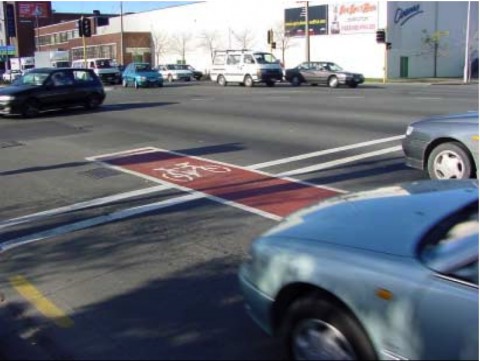
In approximately 1975, the then Christchurch City Council, in conjunction with the National Roads Board, marked a cycle lane up to the intersection limit lines on the Kilmarnock Street approach to the Deans/Kilmarnock intersection in Christchurch. In 1978 the Ministry of Transport produced a draft standard for the design of cycle facilities. The draft was approved by the National Roads Board for a trial that was conducted by the Traffic Committee of the Road Research Unit, in 1980.
The trial involved an investigation into the operating and attitude effects of mid-block cycle lane markings, cycle symbols and cycle route signage. Although the cycle lane at the Deans/Kilmarnock intersection was part of the overall package of cycle facilities under investigation, it was not specifically studied for behavioural, safety or attitude effects. The report simply stated “the provision of a special cycle lane at signals appears justified, in our view, only when cyclists are permitted a turn which other vehicles cannot make.”
The report did investigate the effects on cyclists at two signalised intersections that had no specific cycle markings. Both approaches were marked with two traffic lanes – combined left-turn/straight-through and combined straight-through/right-turn (Kilmarnock/ Straven intersection). The report concluded that “the two traffic signal controlled intersections on Kilmarnock Street have been observed and while the adopted markings may be ‘non-solutions’ they appear to work satisfactorily.”
In summary, the 1980 investigation recommended no treatment at most signalised intersections, and cycle lane treatment only where cyclists were permitted a turn that vehicles could not make.
These recommendations were reflected in MOTSAM – the Transit NZ & LTSA Manual of Traffic Signs and Markings, and the Guide to Cycle Facilities – the “blue book” published in 1983. A 2002 report by Christchurch City Council noted that both of these manuals remained the effective New Zealand cycle facilities design manuals of the day. Neither explicitly stated the “non-solution” solution, but indicated that cyclists should join the traffic flow at intersections without cycle specific markings. They also said that cycle lanes up to limit lines at intersections should only be used when cyclists can make a movement that vehicles cannot.
The 2002 CCC report considered other design options for cycle facilities at intersections, taking into account best practice overseas; these include tools like advance cycle lanes and advance stop boxes. Observation and attitude surveys were undertaken based on trial installations around Christchurch. Since then, NZ best practice (in terms of MOTSAM, Austroads, and the Transit NZ supplement) now recommends better provision for cycling at intersections, much of it reflecting the pioneering CCC study and facilities on the ground in Christchurch a decade ago.
Download 2002 CCC study below (PDF 200KB)
| Attachment | Size |
|---|---|
| 209.28 KB |
